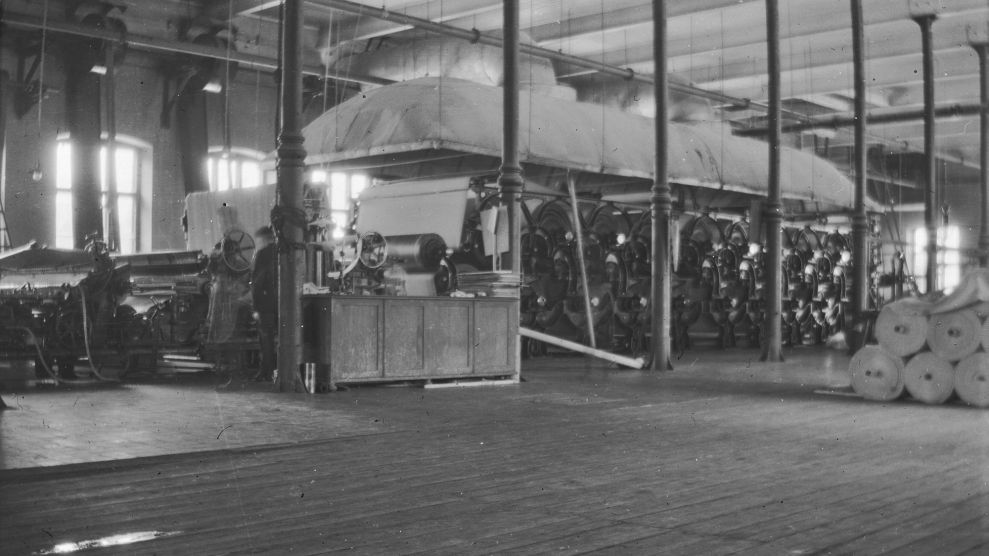
Paper mill from the early 1900sZuma
This story was originally published by Slate and is reproduced here as part of the Climate Desk collaboration.
Last fall, the specialty paper maker Dunn Paper closed its mill in Port Huron, Michigan, where, for about a century, it had been making paper used everywhere from the food industry to medical settings. In March, the packing paper firm Sonoco announced it would permanently shutter its Hutchinson Paper Mill—which turned 100 more than a decade ago—and lay off scores of workers.
In North Carolina, paper manufacturer Pactiv Evergreen closed a plant in Canton with approximately 1,000 workers—despite the pleadings of the state’s governor. The company was so central to the area’s economy that high school students were reportedly still finishing up paper and pulp trade classes meant to prepare them for working at the plant.
At first glance, the closure of America’s mills might make intuitive sense. Today, payment platforms text us receipts and college admission decisions are first announced via online portal. Banks charge for monthly statements sent via snail mail. No one says “Think Before You Print,” because no one needs to hear it.
This was one promise of digitization. Personal computers and the internet were supposed to obviate the need for a lot of paper. And in many ways, they did. Emails and texts have replaced a large swath of nondigital written communication, and the cloud serves as an alternative to hard copies. As a result, annual worldwide production of printing and writing papers has declined by about 30 percent since its high in 2007.
But that’s not quite why American paper mills, overall, are closing. Many of the mills closing in the US don’t make this kind of paper, and the diminishing relevance of printer paper hasn’t spelled the end of Big Paper, anyway. Annual production of paper and paperboard has grown by about 60 percent since 1993, according to statistics collected by the United Nations. And amid the race to combat climate change, the paper industry is now hoping to compete with products that are traditionally made with plastic, like straws and bottles. (Recycling notwithstanding).
There’s one simple reason why paper is still popular. A growing global population means people need more of the paper-based products we’ve always needed, like tissue paper, napkins, tea bags, and disposable cutlery. “Sanitary-type paper is in constant growth,” says Burak Aksoy, a research professor who studies new papermaking technologies at Auburn University’s Forest Products Development Center.
But much of the increase in demand for paper can be tied to one of the most significant byproducts of digitization: online shopping. E-commerce, which now accounts for nearly 15 percent of all sales in the US, depends on a litany of paper-based products, including cardboard boxes, shipping labels, and packing paper. While the digital era indirectly killed a huge chunk of the paper business, companies like Amazon and Alibaba now represent one of its biggest opportunities.
“Paper has been around for over 2,000 years, and the fundamentals of papermaking have not really changed during that process,” says Virginia Howell, the director of the Robert C. Williams Museum of Papermaking at Georgia Tech. “When you’re looking at a box that’s made out of cardboard, is that the same kind of paper as the paper that is printed in books? Well, yes, it is, but the fibers have been treated in different ways.”
Historically, reports of paper’s death have been exaggerated. At the turn of the millennium, the Forest Products Association of Canada boasted that as demand for personal computers grew, people were also purchasing hundreds of millions of personal printers. Just a few years later, Malcolm Gladwell noted in the New Yorker that “every country in the Western world” used more paper per person than they had a decade earlier.
In the US, the American Forest and Paper Association, a trade organization that represents the paper and wood products sector, reports that demand for paper that’s used for printing and writing has declined about 50 percent, and demand for newsprint has declined even more drastically, by about 90 percent, since 1990. But during the same period, demand for all sorts of packing-related paper has grown by about 33 percent. Total US demand for paper and paperboard has only declined by less than 20 percent since 1990.
This trend makes sense if you consider the packaging needed to ship something directly to your house instead of picking it up at a local store. For the same reason, the pandemic-era surge in e-commerce spending spurred record production of containerboard, which is used to make cardboard boxes. While some of that demand is declining as people adapt to a leaner economy and more regular spending patterns, the paper industry stands to benefit as e-commerce continues to grow.
In fact, the pivot to online shopping has inspired some of the newest investments in American paper manufacturing. The first new paper mill in Wisconsin in more than three decades, a $500 million facility built by a company called Green Bay Packaging that opened in 2021, focuses on the outer material and internal components used in cardboard boxes. In Skowhegan, Maine, the papermaking giant Sappi is converting a paper machine to produce bleached sulfate board—a kind of environmentally sustainable packaging that’s frequently used for coffee cups and cosmetics products.
Between 2018 and today, about a dozen mills have converted or shifted production from communication paper to packaging paper, according to the AFPA. “There are companies who are making the papers you don’t think about,” says Howell, from the paper museum. “There’s a lot of filter paper that’s being made by companies. But then you even have things like the papers for cigarettes, the papers that show up in your candy bars and hold your Reese’s cup.”
Of course, changing tech habits isn’t the only factor that’s pushing the paper industry to shift gears. Along with increased automation and competition from abroad, the paper business has faced the growing influence of Wall Street. Over the past several decades, large companies have brought increased pressure to boost profits and reduce labor costs, according to Michael Hillard, an economics professor at the University of Southern Maine who’s written about the history of the state’s paper industry. That’s contributed to mill closures and declining employment in the US, even as the industry has grown abroad.
“You got automation, financialization, globalization,” explains Hillard, “The real game changer was the entry of China into the World Trade Organization in 2001.”
There’s also the climate crisis. Paper, after all, is made by chopping down carbon-sequestering trees, and the process of turning pulp into paper is energy-intensive in its own right.
Still, even as big tech companies keep pushing the Next Big Things, there’s no sign that paper is going away any time soon. There are still Post-its and notebooks on our device-laden desks, and piles of folded delivery boxes sit by our front doors. It’s a reminder of how technology can disrupt something without actually displacing it.
This article is part of Future Tense, a partnership of Slate, New America, and Arizona State University that examines emerging technologies, public policy, and society.













